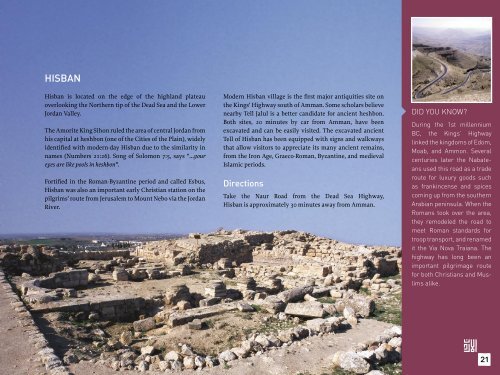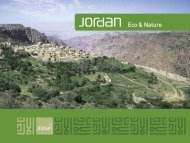You also want an ePaper? Increase the reach of your titles
YUMPU automatically turns print PDFs into web optimized ePapers that Google loves.
HISBAN<br />
Hisban is located on the edge of the highland plateau<br />
overlooking the Northern tip of the Dead Sea and the Lower<br />
Jordan Valley.<br />
The Amorite King Sihon ruled the area of central Jordan from<br />
his capital at heshbon (one of the Cities of the Plain), widely<br />
identified with modern-day Hisban due to the similarity in<br />
names (Numbers 21:26). Song of Solomon 7:5, says “…your<br />
eyes are like pools in heshbon”.<br />
Fortified in the Roman-Byzantine period and called Esbus,<br />
Hisban was also an important early Christian station on the<br />
pilgrims’ route from Jerusalem to Mount Nebo via the Jordan<br />
River.<br />
Modern Hisban village is the first major antiquities site on<br />
the Kings’ Highway south of Amman. Some scholars believe<br />
nearby Tell Jalul is a better candidate for ancient heshbon.<br />
Both sites, 20 minutes by car from Amman, have been<br />
excavated and can be easily visited. The excavated ancient<br />
Tell of Hisban has been equipped with signs and walkways<br />
that allow visitors to appreciate its many ancient remains,<br />
from the Iron Age, Graeco-Roman, Byzantine, and medieval<br />
Islamic periods.<br />
Directions<br />
Take the Naur Road from the Dead Sea Highway,<br />
Hisban is approximately 30 minutes away from Amman.<br />
DID YOU KNOW?<br />
During the 1st millennium<br />
BC, the Kings’ Highway<br />
linked the kingdoms of Edom,<br />
Moab, and Ammon. Several<br />
centuries later the Nabateans<br />
used this road as a trade<br />
route for luxury goods such<br />
as frankincense and spices<br />
coming up from the southern<br />
Arabian peninsula. When the<br />
Romans took over the area,<br />
they remodeled the road to<br />
meet Roman standards for<br />
troop transport, and renamed<br />
it the Via Nova Traiana. The<br />
highway has long been an<br />
important pilgrimage route<br />
for both Christians and Muslims<br />
alike.<br />
21



